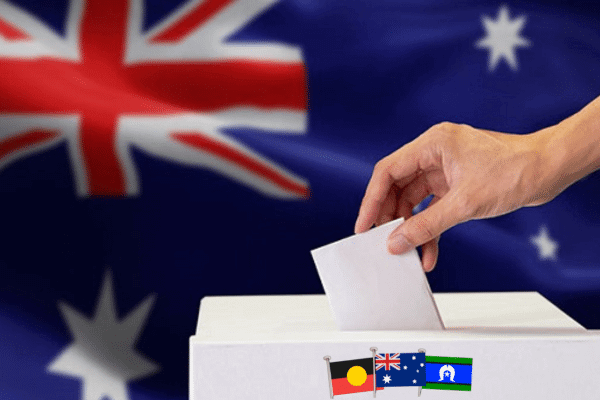Later this year, Australians will go to the polls for one of the rarest of Australian political events: a constitutional referendum. An election night pledge by Anthony Albanese, the referendum will ask Australians whether the Constitution should be amended to establish an Australian Indigenous Voice.
Referendums can be confusing at the best of times, and as the “Yes” and “No” campaigns ramp up over the coming months, we explain what it all means:
Hold on – what’s a referendum?
A referendum is a public vote that is legally required to make a change to the Australian Constitution.
A referendum requires a “double majority” in order to be successful, meaning the change must be passed by not only a majority of voters across all states and territories – but a majority of voters in a majority of states, i.e. at least 4 out ofthe 6 Australian states must approve the amendment.
Okay, so what’s the Australian Indigenous Voice referendum about?
The Australian Indigenous Voice referendum will ask voters the following question (with the wording of the question still subject to Parliament approval):
“A Proposed Law: to alter the Constitution to recognise the First Peoples of Australia by establishing an Aboriginal and Torres Strait Islander Voice. Do you approve this proposed alteration?”
It’s a request taken directly from the Uluru Statement of the Heart, a 2017 petition by Australian Aboriginal and Torres Strait Islanders which calls for, amongst other acknowledgements and constitutional reforms, “the establishment of a First Nations Voice enshrined in the Constitution”.
If the referendum is passed, the Constitution will be amended to create an Aboriginal and Torres Strait Islander “Voice”, a new advisory body tasked with representing Indigenous Australians to the Australian Parliament on matters relating to Aboriginal and Torres Strait Islander people.

What powers will the Aboriginal and Torres Strait Islander Voice have?
The Voice will provide independent advice to the federal government on decisions, policies and laws that affect the lives of First Nations people across Australia, including matters relating to their social, spiritual and economic wellbeing. Examples include native title, housing, community development, NDIS, and heritage protection.
It will not have the power to overrule parliament, deliver services or manage government funding. It’s also worth bearing in mind that there’s no potential for “scope creep” here – any further powers would require a further amendment to the constitution, meaning another referendum.
If the referendum is passed, how will the Voice be selectedand structured?
The details of how the Voice will be implemented will be subject to confirmation if the referendum is passed, but that doesn’t mean the details are not available.
The Indigenous Voice Co-design Process Final Report to the Australian Government, co-authored by Professors Tom Calma AO and Marcia Langton AM, sets out a detailed recommendation on how the Voice should be structured, after 18 months of consultation with nearly 10,000 people and organisations, 115 community consultations in 67 locations, nearly 3,000 submissions, and over 1,000 surveys.
The 272-page report recommends, broadly, that the Voice should comprise a National Voice and a Local & Regional Voice, as follows:
- the National Voice will have 24 members, with enshrined gender balance and reflecting a representative cross-section of Australia’s states and territories (and of the Torres Strait).
- 35 separate Local and Regional Voices will collectively determine the National Voice members for their state, territory and the Torres Strait.
Each Local and Regional Voice will be distinct and individually run by the communities which it represents, reflecting the diversity of Aboriginal and Torres Strait Islander communities. As the report notes, “Aboriginal and Torres Strait Islander peoples are not an homogenous group where one solution will fit all communities”.

When will the referendum be held?
The referendum will be held on a Saturday, some time in October 2023. It’s a big deal: this will be the first referendum since the 1999 proposal to amend the Constitution to establish Australia as a republic, rather than a constitutional monarchy.
This means it will be the first referendum in many Australians’ lifetimes, and a momentous occasion regardless of how you vote.
And if passed, it’ll be the first successful change to the Australian constitution since 1977, when the electorate passed three proposals simultaneously: introducing a retirement age for judges, providing for the same-party replacement of casual vacancies in the senate, and giving citizens who lived in Australian territories the right to vote.

Do I have to vote?
Yes – unlike plebiscites, enrolling and voting in referendum is compulsory for all Australian citizens aged 18 and older, just like an election. If you’re already enrolled to vote, you don’t need to enrol again to vote in the Voice referendum.
And just like an election, there will be pre-polling booths, postal votes, and polling places on the referendum day itself.
Should I vote ‘yes’ or ‘no’?
It’s your vote, and your decision.
At Indian Link, we believe the time has come for Australia to take a step forward in stopping the torment of the powerlessness of Aboriginal and Torres Strait Islanders in their own country, and to improve Australia’s relationship with them.
Read more: Will multicultural Australians support the Voice campaign?




